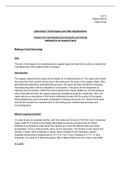Unit 4
Assignment B
Diana Duka
Laboratory Techniques and their Applications
Explore the manufacturing techniques and testing
methods for an organic liquid
Making a Food Flavouring
Aim
The aim of this report is to manufacture an organic liquid and test for its purity, as well as the
manufacturing of the organic liquid in industry.
Introduction
The organic liquid that the report will be based on is called banana oil. The report will include
the production from scratch all the way to the testing for the purity of the organic liquid. After
describing the laboratory manufacturing process, the report will also include the industrial
manufacturing which will be compared to one another. The purity will be measured by
refluxing the end product. While the impure banana oil is being heated up, the temperature
will be recorded at which the organic liquid has travelled through the condenser. Also, the
report will give a description of the factors affecting the yield and the purity of the organic
liquid obtained as well as the tests conducted to measure the purity of it. Some of the tests
that will be included are measurement of the boiling point, infrared spectroscopy and
chromatography.
What is Isoamyl alcohol?
It is also known as isopentyl alcohol, with the molecular formula of C5H12O and a molecular
mass of 88.15. It is found to be highly flammable as well as corrosive and an irritant,
therefore it is advised to keep away from flames and rinse the affected area with water
immediately. It has a mild alcoholic odour and is colourless. The alcohol is less dense and
soluble in water, which produces a vapour that is irritating to the respiratory system.
Isopentyl alcohol has a boiling point of 131°C to 132°C and a melting of 117°C. In food
industries, it is used as a flavouring agent, with a taste of floral, burnt or cocoa, reportedly.
Is it safe?
, It is highly toxic and should not be consumed in higher doses than 50mg per 70kg of a
person's weight, as it is fatal. It should not be inhaled in large amounts due to the mild odour
that can cause headaches and lightheadedness as well as dizziness.
What is Banana Oil?
Banana oil, also known as Isopentyl Acetate, is a flammable organic liquid with a molecular
formula of C7H14O2 and a molecular weight of 130.18. It is mainly used as food flavouring
and has a reportedly strong smell of bananas and pears and can mix with water. It is an oil
based, colourless liquid that can also float on water and can be quite irritating to the
respiratory system if inhaled. It has a boiling point of 135℃ to 143℃ and a melting point
between -78.5℃ to -79℃.
(2.)
Is it safe?
Banana oil is a flavouring agent, which can be consumed in small amounts. It can be
consumed orally but it may cause inflammation and irritation of the skin and gastrointestinal
problems if used excessively. Always make sure that it is from a trusted source and is pure.
Reflux - it is the heating of an organic compound for a set amount of time.it is used in
experiments, laboratories and industries to give a higher yield of the organic compound.
Organic compounds are volatile and are easily lost or overheated, as it will evaporate over
time. The compound usually has low boiling points, which makes it easy to heat and take
little time to reach the boiling point. Whilst boiling the compound, the condenser used in
reflux, cools down the vapour given off.
Distillation - it is used to separate mixtures of different boiling points. This is done by
heating the compound. Some of the components will turn into a gas, which is collected as
vapour in the condenser. There is a process called double distillation, where the compound
is distilled twice to increase the purity of the product. There are different types of distillation
used in the industry, such as simple distillation, fractional distillation and destructive
distillation. It is used in the production of alcohol, paraffin, kerosene etc. (2.)
Purity
Purity can be measured by finding the boiling point and melting point of a substance. If the
stated melting and boiling points do not match the obtained points of the substance then it is
likely that the sample used was impure. The purity of a substance can also be measured by
chromatography to determine the amount of each component.
Factors affecting the purity
● Contamination
● Excess chemicals used
● Incomplete reaction




